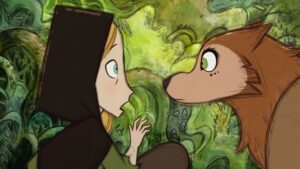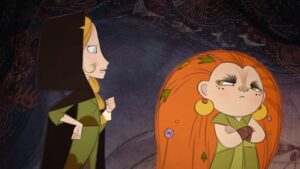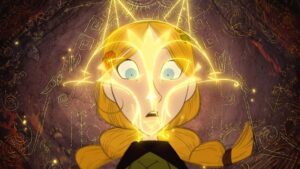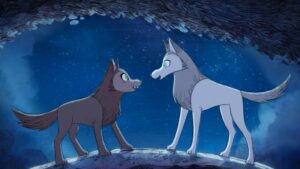 Wolfwalkers is the latest animated film from Directors Tomm Moore and Ross Stewart. The animated movie follows Robyn (voiced by: Honor Kneafsey) as she and her father are charged to eliminate the last wolf pack in Ireland. An unexpected encounter with a wild girl Mebh (voiced by: Eva Whittaker) that changes into a wolf leads to a new found friendship. After Mebh accidentally bites Robyn, Robyn soon shifts her perspective as she becomes a fellow wolfwalker by transforming into a wolf while sleeping. The animation style illustrates a very eclectic approach led by the teams from the “Wolfvision” Supervisor/Animator Eimhin McNamara and Lead Character Animator Federico Pirovano.
Wolfwalkers is the latest animated film from Directors Tomm Moore and Ross Stewart. The animated movie follows Robyn (voiced by: Honor Kneafsey) as she and her father are charged to eliminate the last wolf pack in Ireland. An unexpected encounter with a wild girl Mebh (voiced by: Eva Whittaker) that changes into a wolf leads to a new found friendship. After Mebh accidentally bites Robyn, Robyn soon shifts her perspective as she becomes a fellow wolfwalker by transforming into a wolf while sleeping. The animation style illustrates a very eclectic approach led by the teams from the “Wolfvision” Supervisor/Animator Eimhin McNamara and Lead Character Animator Federico Pirovano.
Wolfwalkers comes from the same Irish studio Cartoon Saloon, who previously produced The Secret of Kells and Song of the Sea. McNamara stated, “There was an organic progression. They started off very rigidly stylistic and then made it more fluid like a graphic dimensionality. Wolfwalkers pushed more with graphic line work as well. In terms of the cleanup style for the characters, there’s different types of cleanup, one for the town which was chunkier and blockier and one for the woods which was rougher. There are many ways in which they combined lots of different techniques. It was like TV paint with a little tiny bit of Warhol for big crowd scenes, but it was mostly all drawn frame by frame.”
The main characters Robyn and Mebh are structurally shaped inversely from one other. Pirovano defined, “The two humans, Robyn and Mebh were designed by Lead Posing Artist and Animator Sandra Norup Andersen, one of the designers that works at Cartoon Saloon. I designed them as wolves, so we collaborated on it. The idea was that the two characters are made to be relating to each other, but very different because their shape represents very different personalities. First of all, Mebh is younger than Robyn, but physically stronger. Mebh is much rounder, stockier, a bit thicker, and wilder. Her shape represents the round shapes we can see in the forest, very free. Robyn is much more square with sharp angles, she’s constrained, older, and has already started growing. When we had to translate that as wolves, it was a bit hard because we didn’t have a lot of space to play with it. They needed to look like wolves and they needed to look like the characters, so we cannot go too wild with the design. What we did is that we translated those main characteristics in the wolf form. We’re going to have one that is slenderer and the other a little stockier, have a size difference, and give them colors we would trace through the forest. We decided to use their exact same eyes that they have as a human. Then it becomes extremely easy to see the same character.”

The wolfwalkers are set apart and distinguished from the generic wolves. “The first characters we defined wolf wise were the generic wolves. When we define the generic wolf shape language, then we can decide how the other characters are going to fit in that. The idea with the generic wolves was to make them a character that could pass from one moment to be goofy and playful to very scary in the other sense. It was a choice to make them skinny, but with very big fangs. They cannot be really scary in some moments or extremely scary in others. We took some choices to make the black eyes or the very big snout that would allow to be very cartoony sometimes and other times just very menacing. After that, we know that the generic wolves are black and slender. We know that they’re going to be stockier because Bill (Robyn’s dad) is a big guy and Moll (Mebh’s mom) is a big woman as well. In general, the wolfwalkers are bigger when they become adults and they have different colors, that’s one of the easiest ways to identify them. They try to keep some of the characteristics of the character they wear,” Pirovano distinguished.
To demonstrate the perspectives and vision of the wolves, McNamara created this technique known as the “wolfvision.” “While Federico was refining what the wolves looked like, I was trying to figure out the eyeline of the characters, the heights of the wolves, and other angles from what the wolves are looking. It took a little bit of bouncing between the style of the town, the style of the forest, and also the limitations of having to draw everything on paper. Initially, we had some final line mark, concept art, and some style frames that were produced for certain sequences. From that I did some tests, figuring how much does stuff need to move, how active the line needs to be, and does it need to be very precise or it can be looser. Once I figured that out, we used 3D Previs for the majority of the “wolfvision” sequences. It was basically an under-drawing structure so that when we’re working on paper, we’re not just going blind, all the camerawork has been decided, and we don’t need to do a retake and redraw everything of a stack of 150 pages. It was very much trying to match and complement what was already in the film style wise. I was obeying the same rules of fluidity or rigidity, depending on whether it’s the woods or the forest,” McNamara envisioned.
The wolfwalkers traced a certain healing ability whereas magical glowing yellow lines appeared. Pirovano highlighted, “We had a lot of great work from a French intern. She did a lot of very cool Pictish Celtic designs and then the director wanted to explore and simplify that. It was really about trying to mix the wolf symbols with those primitive Celtic designs, so a bunch of sketches were made. Then later those went to the VFX supervisors and they tried to give them a way of moving. A lot of it comes from the previous thing that the intern did.”

The village people were an extension of the background. “The idea was really to use that blocky idea as an inspiration to create the characters, so we could be much more stylized. The idea was that they would blend in the background. If we look at the main characters and the town people closely, their style doesn’t necessarily match perfectly because the town people are more part of the background. We felt really two-dimensional because they didn’t need to move in a two-dimensional space. We really planned it to be extremely geometric, sometimes even Cubism, in the sense that there would be completely different to those. Tomm really insisted to have interesting background characters because most of the time, they’re just very bland. He wanted this feeling of real life and real people that were wandering about the town,” Pirovano enlightened.
The animation style of the village and the forest varied tremendously. McNamara elaborated, “For the town, it was stylistically referencing woodblock printing from the 16th and 17th century. It was about those hard edges and texture we get. In woodblock prints, we never get a flat form of color, always get a little bit of texture, little holes that the pigment didn’t take. The idea was to replicate that. One of the final line illustrators Clara de Frutos works with linocut a lot. We didn’t do linocuts for all of the backgrounds of Wolfwalkers, they developed a technique where they could work in negative. Basically, they would use these wide stroke calligraphy pens to mimic the blocks and then invert them, so we have the gaps in between or the bits we’re carrying away. Similarly, for the forest, it was more pencil and graphite lines. It wasn’t so much about a rigid form or a structure, it was more about the flow and fluidity so it was much looser. Even though the town had a graphic rigidity, it didn’t have much perspective. The forest did not have any structural rigidity, it had depth like a tunneling effect because of the way that the trees go around each other as they come towards us, they kind of envelop us. That was just working with the flow of the line. Then we had the Color Supervisor Stefano Scapolan and his team worked with watercolor washes and some stamps for the town, like scan stamps that they would reposition and relocate. The characters are also stylized in a certain way to match the woodblock printing in the town. The colors of the characters are actually offset from the linework. It really helps to make the characters in the town fit in the world and in the background.”
Combining all these various animation styles was an intricate and complicated process. “There’s three different styles of the wolf animation; one where they were more graphic where they would flow together and other ones where it was a bit more anatomical. We had a really good animator that was good with water beds. The “wolfvision” stuff was all hard because I had to develop a 3D pipeline and a traditional pipeline side by side. They needed to converge with whatever was happening and being developed in the main production of the studio. I basically had to coordinate with all of the other departments to make sure continuity wise stuff was happening. Cartoon Saloon is a 2D studio, so we wanted to use 2D animation. They are able to turn around things and because of the quality of the artists. If they need to adjust something, it’s quite easy to adjust something because it’s one background or color palette they need to adjust. The nature of how I was doing “wolfvision,” if they changed our table in the previous shot, but I had already rendered stuff on paper, I would have to restart everything, go back to the 3D printers, update the model of the table, and then redraw everything on top of it again to render the textures on the mark making. It’s a balancing act,” McNamara explained.

Wolfwalkers embraces multiple animation styles ranging from 3D, 2D, linocut, calligraphy, woodblock printing, TV Paint, Warhol animation, Pictish Celtic designs, water beds, and graphic dimensionality seamlessly embedded together. The main characters were specifically tailored to represent their personalities in both their human and wolf forms. The animation design with the village and the forest are polar opposites with one being structurally rigid and the other free flowing fluidity.
Wolfwalkers is the third installment from director Tomm Moore’s “Irish Folklore Trilogy.” Wolfwalkers is an international co-production from animation studio Cartoon Saloon based in Ireland in collaboration with Mélusine Productions in Luxembourg. The film had a theatrical release from GKIDS and is now available on Apple TV+ for streaming. The acclaimed animated film has won numerous awards.





